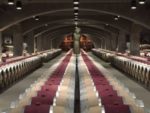Due to the shutdown imposed by the pandemic, producers in the Casale Monferrato region skipped the year of previews but returned in style organizing the ”Monferace en Primeur” event at Ponzano Castle, home of the Monferace Association since 2015. The purpose was to present the latest vintage of Monferace wine, also known as Grignolino (a native Piedmont red grape) aged in wood.
The independent Monferace Association has several production rules wineries must follow: Monferace must be produced only in the best vintages from Grignolino grapes and can only be marketed after a minimum aging period of 40 months, calculated from November 1 of the year of harvest, including at least 24 months in wooden barrels. Registered vineyards must be planted on calcareous-silt-clay soils, in various combinations, including those with natural presence of sandy sediments. Vineyard areas are developed in 24 municipalities of Monferrato Aleramico and must be exclusively hilly, with suitable exposures to ensure the best ripening of the grapes. In addition, the number of vines per hectare cannot be less than 4,000; the maximum grape yield must not exceed 7 tons per hectare.
”Aspects that are not secondary, indeed fundamental, Monferace is the most authentic expression of our terroir, which we hope is expressed today with the wines born in 2018; we hope they will continue to do well in the future. 2018 looks like a very confident vintage with the history of Monferace, the wines show great elegance and long aging potential”- commented Guido Carlo Alleva, President of the Monferace Association and owner of Tenuta Santa Caterina. Monferace is the aleramic name of Monferrato, it represents the revival of an ancient tradition, the production of a wood-aged grignolino, which is seeing a rising number of producers: Accornero, Alemat, Angelini Paolo, Cinque Quinti, Fratelli Natta, Hic et Nunc, Liedholm, Sulin, Tenuta la Fiammenga, Tenuta la Tenaglia, Tenuta Santa Caterina, and Vicara.
An important milestone for the producers was reached with the request, and obtaining, the inclusion of the Riserva type in the Grignolino Monferrato Casalese production regulations, but the Monferace Association, in addition to relying on ancient winemaking protocols, observes the roots and began an in-depth study of its vineyard park by engaging in a mapping of the vineyards dedicated to the production of Monferace observing that among them are Grignolino clones from 1936 (Cascina Faletta) and 1961 (Accornero); more recently, in 2020, the Saulin winery planted 45 clones derived from a selection of clones from the 1990s. A protection activity that allows the study of a territory aimed at understanding the soils and which clones perform best in them.
Dealing with the production choices the period of maceration between short and long, affects the fruity presence and structure, which we are going to describe in the following lines.
Erika Montovan




